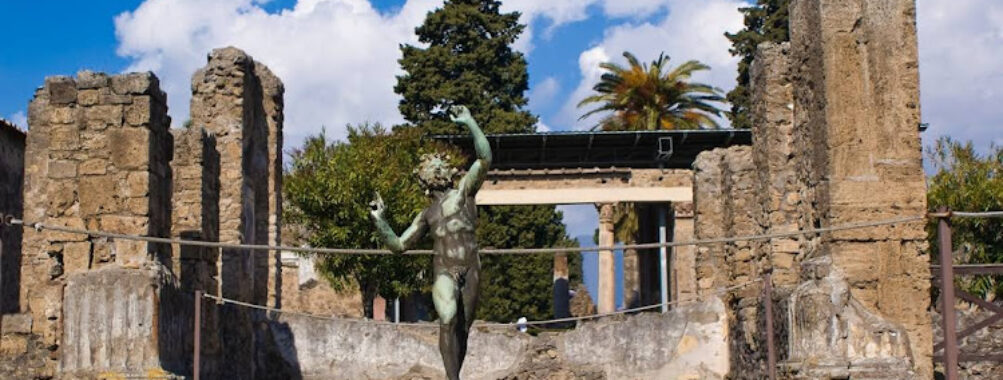
House of the Faun
Table of Contents
Description
The House of the Faun stands as one of Pompeii’s most impressive ancient Roman dwellings, sprawling across an entire city block. Dating back to the 2nd century BC, this magnificent residence earned its name from the bronze dancing faun statue (now a replica) that once graced its impluvium. I’ve visited countless Roman ruins across Italy, but there’s something uniquely captivating about this particular domus – maybe it’s because you can actually walk through the various rooms and imagine the daily life of its wealthy inhabitants.
The sheer size of this place will stop you in your tracks – we’re talking about 32,000 square feet of luxury living space! The house showcases some of the finest examples of Roman mosaic art I’ve ever encountered, including the famous Alexander Mosaic depicting Alexander the Great’s victory over Persian King Darius III. Y’know, it’s pretty mind-blowing to think these intricate designs have survived for over two millennia.
What really gets me excited about this place is how it reveals the sophistication of Roman engineering and architecture. The house features two atria (that’s fancy Roman for courtyards), four dining rooms, and private bath facilities – talk about ancient luxury living! The detail in the decorative elements is absolutely incredible, from the Tuscan columns to the delicate frescoes that still cling to some walls.
Key Features
• The iconic Alexander Mosaic, measuring an impressive 5.82 x 3.13 meters, considered one of the finest examples of ancient Roman art
• Two stunning atria with impluviums (rainwater collection basins)
• Original marble flooring in several rooms
• The famous dancing faun statue replica
• Four separate triclinia (dining rooms) for different seasons
• Perfectly preserved geometric mosaic patterns throughout
• Private bath complex
• Original Tuscan-style columns
• Multiple garden areas with remaining archaeological evidence
• Sophisticated water management system
Best Time to Visit
From my experience, the best time to explore the House of the Faun is during the shoulder seasons – April to mid-June or September to October. The weather’s just perfect then, and you won’t have to battle the intense summer crowds or heat. Trust me, trying to appreciate ancient mosaics while sweating buckets in August isn’t exactly fun!
Early mornings (right when the site opens) or late afternoons tend to be less crowded. I’d suggest avoiding weekends if possible – that’s when the tour buses really pack in. And here’s a pro tip: rainy days actually make for amazing visits because the crowds thin out significantly, plus the ancient stones take on this beautiful, rich color when they’re wet.
How to Get There
Getting to the House of the Faun is pretty straightforward once you’re inside the Pompeii archaeological site. After entering through the main entrance (Porta Marina), follow the main street, Via Marina, which leads into Via dell’Abbondanza. You’ll want to make a left onto Via della Fortuna, and boom – you’re there! It’s about a 10-15 minute walk from the entrance.
If you’re coming from Naples, catch the Circumvesuviana train to the Pompei Scavi-Villa dei Misteri station. The journey takes around 35 minutes, and trains run pretty regularly throughout the day. From Rome, you can take a high-speed train to Naples, then transfer to the Circumvesuviana – the whole trip usually takes about 2.5 hours.
Tips for Visiting
Look, I’ve learned a thing or two from my visits here, and I gotta share some real talk about making the most of your experience. First off, download a good audio guide app before you arrive – the on-site information is pretty limited, and you’ll want to understand what you’re looking at. I made the mistake of not doing this my first time and missed out on so many fascinating details!
Wear comfortable shoes with good grip – those ancient Roman streets can be super slippery, especially after rain. And bring water, lots of it! There’s not much shade around the house, and the Italian sun can be brutal.
Try to give yourself at least 45 minutes just for the House of the Faun – there’s so much to take in, and you’ll kick yourself if you rush through it. Early morning visits are amazing because the light hits the mosaics just right for photos.
Oh, and don’t forget to look up! The architectural details above eye level are often overlooked but tell us so much about Roman building techniques. I totally missed some gorgeous ceiling details my first time because I was too focused on the floor mosaics.
If you’re really into photography, bring a wide-angle lens – the house is massive, and you’ll want to capture those grand spaces. And one last thing: respect the ropes and barriers. I know it’s tempting to get closer to those amazing mosaics, but preservation is super important for future generations to enjoy this incredible piece of history.
Location
Places to Stay Near House of the Faun
Find and Book a Tour
Explore More Travel Guides
No reviews found! Be the first to review!